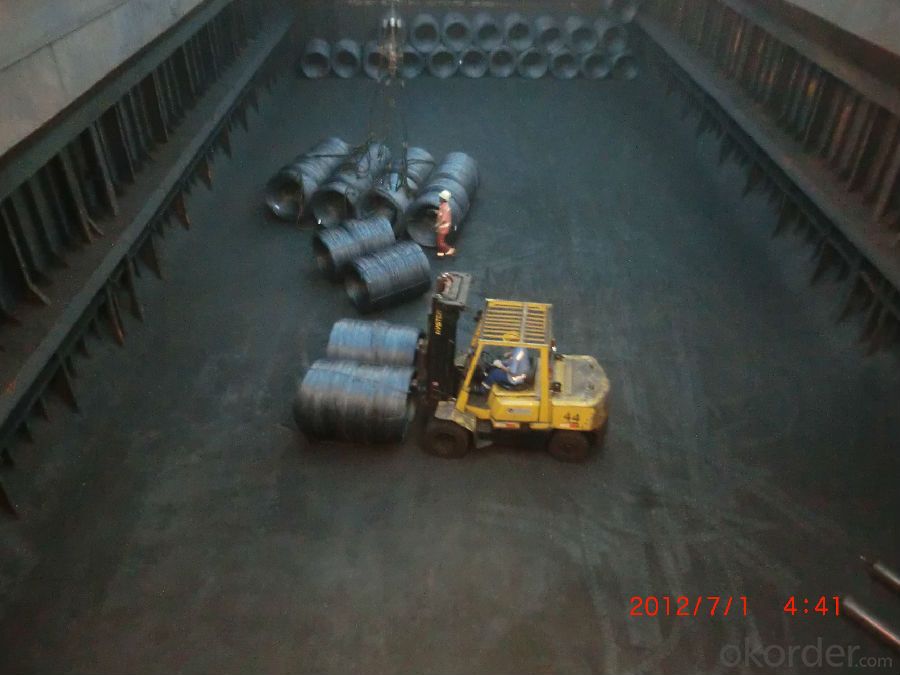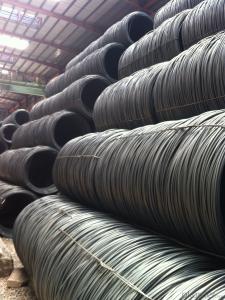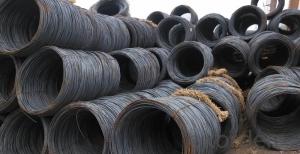Hot Rolled Steel Wire Rod Low Carbon for Nails
- Loading Port:
- China main port
- Payment Terms:
- TT OR LC
- Min Order Qty:
- 100 m.t.
- Supply Capability:
- 10000 m.t./month
OKorder Service Pledge
OKorder Financial Service
You Might Also Like
Specification
OKorder is offering Hot Rolled Steel Wire Rod Low Carbon for Nails at great prices with worldwide shipping. Our supplier is a world-class manufacturer of steel, with our products utilized the world over. OKorder annually supplies products to African, South American and Asian markets. We provide quotations within 24 hours of receiving an inquiry and guarantee competitive prices.
Product Applications:
Hot Rolled Steel Wire Rod Low Carbon for Nails are ideal for structural applications and are widely used in reinforcement of reinforced concrete and welded structure or reprocessed (roberts , nail, etc.) materials, especially used to produce wire drawing, welding electrode, nails, spring, electronic, precise machinery parts and so on.
Product Advantages:
OKorder's Hot Rolled Steel Wire Rod Low Carbon for Nails are durable, strong, and wide variety of sizes.
Main Product Features:
· Premium quality
· Prompt delivery & seaworthy packing (30 days after receiving deposit)
· Can be recycled and reused
· Mill test certification
· Professional Service
· Competitive pricing
Product Specifications:
Steel Grade: Q195/235, SAE1006-1018B
Standard: ASTM, GB
Diameter: 5.5mm, 6.5mm, 7mm,8mm,9mm,10mm,12mm,14mm
Type: in coil, coil weight around 2MT
Alloy or Not: Alloy
Technique: Hot Rolled
Place of Origin: China Mainland
Surface: round, no twisted, light and smooth
FAQ:
Q1: Why buy Materials & Equipment from OKorder.com?
A1: All products offered byOKorder.com are carefully selected from China's most reliable manufacturing enterprises. Through its ISO certifications, OKorder.com adheres to the highest standards and a commitment to supply chain safety and customer satisfaction.
Q2: How do we guarantee the quality of our products?
A2: We have established an advanced quality management system which conducts strict quality tests at every step, from raw materials to the final product. At the same time, we provide extensive follow-up service assurances as required.
Q3: How soon can we receive the product after purchase?
A3: Within three days of placing an order, we will arrange production. The normal sizes with the normal grade can be produced within one month. The specific shipping date is dependent upon international and government factors, the delivery to international main port about 45-60days.
Images:


- Q: How is steel wire rod processed into different wire products?
- Steel wire rod is processed into different wire products through a series of manufacturing steps. Firstly, the steel wire rod is cleaned and coated to prevent rusting. Then, it is passed through a series of rolling mills to reduce its diameter and increase its length. This process is called drawing. After drawing, the wire is further processed through annealing, where it is heated and cooled to improve its ductility and strength. Next, the wire is passed through various machines to shape it into different products such as wires for fencing, nails, or electrical cables. Finally, the wire products undergo surface treatments like galvanization or coating to enhance their durability and corrosion resistance.
- Q: How does steel wire rod compare to other materials for wire production?
- Steel wire rod is widely regarded as one of the most suitable materials for wire production due to its exceptional strength, durability, and versatility. Compared to other materials, such as aluminum or copper, steel wire rod offers superior tensile strength and resistance to corrosion, making it ideal for various applications. Additionally, steel wire rod can be easily shaped, welded, and drawn into different wire sizes and forms, ensuring its compatibility with diverse industries like construction, automotive, and manufacturing. Its cost-effectiveness and widespread availability further contribute to its preference over other materials in wire production.
- Q: How are steel wire rods used in the production of screws and bolts for mechanical assemblies?
- Steel wire rods are an essential component in the production of screws and bolts for mechanical assemblies. These wire rods are made from high-quality steel that provides the necessary strength and durability required for these fasteners. The production process begins with the wire rods being heated and then passed through a series of rollers to reduce their diameter. This process, known as wire drawing, ensures that the wire rods achieve the desired thickness and smoothness required for manufacturing screws and bolts. The wire rods are then cut into smaller lengths, which will serve as the foundation for individual fasteners. Next, the wire rods undergo a cold heading process. This involves placing the wire rod into a die and applying pressure to shape it into the desired screw or bolt head. Cold heading not only forms the head but also creates the necessary thread on the shank of the fastener. This threading is crucial as it allows the screws and bolts to securely fasten different components together. After the cold heading process, the screws and bolts may undergo additional treatments to enhance their performance. These treatments can include heat treatment to further strengthen the steel, plating or coating for corrosion resistance, or even specific coatings for improved lubrication during assembly. Once the screws and bolts are fully formed and treated, they are packaged and prepared for distribution to various industries that rely on mechanical assemblies. These fasteners play a crucial role in holding together different components of machinery, vehicles, and structures, ensuring their stability and functionality. In summary, steel wire rods are utilized in the production of screws and bolts by undergoing processes such as wire drawing and cold heading. These processes shape the wire rods into the desired fastener shape with threaded shanks. The resulting screws and bolts are then used in mechanical assemblies, providing a secure and reliable means of joining components together.
- Q: How is steel wire rod used in the manufacturing of wire for telecommunications cables?
- Wire rod made of steel is an indispensable element in the production of wire for telecommunications cables. The process starts with the creation of steel wire rod, which is a long, cylindrical billet composed of steel. This wire rod is then treated and converted into a wire that is appropriate for telecommunications cables. To manufacture wire for telecommunications cables, various steps are taken with the steel wire rod. Initially, it is purified and descaled to eliminate any impurities that could impact the wire's quality. Subsequently, the wire rod is heated and passed through a series of rollers to decrease its diameter and increase its length. This stage, known as wire drawing, is crucial in achieving the desired thickness and strength of the wire. Once the wire has been drawn to the necessary size, it undergoes further processing to ensure its quality and dependability. The wire is annealed, a process in which it is heated and slowly cooled to relieve internal stresses and improve its flexibility. This makes the wire more suitable for handling and installation in telecommunications cables. Following annealing, the wire is coated with a layer of insulation material, such as polyethylene or polyvinyl chloride (PVC). This insulation provides electrical insulation and safeguards the wire from external factors that could harm its conductivity, such as moisture or extreme temperatures. The final step in the manufacturing process involves twisting multiple wires together to form a cable. Steel wire rod serves as the core strength member within the cable, delivering structural support and tensile strength. This ensures the cable can endure the tension and bending forces it may encounter during installation and operation. In conclusion, steel wire rod plays a crucial role in the production of wire for telecommunications cables. It goes through several processes, including purification, wire drawing, annealing, and insulation, to create a wire suitable for telecommunications applications. The strength and reliability of steel wire rod make it an ideal choice for providing the necessary structural support and durability required in telecommunications cables.
- Q: What are the main trade associations and organizations in the steel wire rod industry?
- Some of the main trade associations and organizations in the steel wire rod industry include: 1. American Wire Producers Association (AWPA): This trade association represents the interests of wire producers, suppliers, and consumers in North America. They work towards promoting the use of wire products and advancing the industry through advocacy, education, and networking. 2. International Wire & Machinery Association (IWMA): IWMA is a global association that brings together wire and cable manufacturers, suppliers, and machinery companies. They organize events, conferences, and exhibitions to facilitate networking and knowledge sharing among industry players. 3. Wire Association International (WAI): WAI is a non-profit association dedicated to promoting the interests of the wire and cable industry worldwide. They offer technical resources, training programs, and industry updates to their members, fostering collaboration and innovation in the steel wire rod sector. 4. International Iron and Steel Institute (IISI): While not specific to the wire rod industry, IISI represents the global steel industry, including producers, distributors, and other stakeholders. They provide a platform for industry collaboration, policy advocacy, and information exchange. 5. Steel Wire Manufacturers Association (SWMA): SWMA is a trade association that represents wire manufacturers in the United States. They advocate for fair trade practices, provide technical expertise, and promote the use of wire products in various industries. These organizations play a crucial role in advancing the steel wire rod industry by providing a platform for collaboration, knowledge sharing, and advocacy. They contribute to the growth and development of the industry while ensuring the sustainability and competitiveness of its members.
- Q: How is steel wire rod used in the manufacturing of wire forms for furniture?
- The manufacturing of wire forms for furniture heavily relies on steel wire rod, a vital component. This wire rod is utilized in various ways to produce robust and long-lasting wire structures, which are essential for constructing furniture pieces. To begin with, steel wire rod acts as the main material for manufacturing the wires used in furniture production. Typically, the wire rod is drawn through a series of dies to achieve the desired diameter and shape. These wires are then employed to create the framework of different furniture items, including chairs, tables, and shelving units. Furthermore, steel wire rod is frequently employed to fabricate furniture springs. Springs are crucial in furniture construction as they provide support, comfort, and flexibility to the seating or bedding surface. By utilizing steel wire rod, manufacturers can fabricate high-quality springs that are resilient and long-lasting. Additionally, steel wire rod is used to reinforce specific parts of furniture. For instance, it can be integrated into the structure of a chair to enhance the stability of the legs or the backrest, preventing potential damage or breakage. Moreover, steel wire rod serves as a medium for creating decorative elements in furniture design. It can be bent, twisted, or shaped into intricate patterns or designs, enhancing the aesthetics of the furniture piece. These decorative wire forms can serve as accents, handles, or even the main design feature of the furniture item. In conclusion, steel wire rod plays a critical role in the production of wire forms for furniture. Its strength, versatility, and durability make it an ideal material for creating the framework, springs, reinforcements, and decorative elements needed in furniture construction.
- Q: How is steel wire rod used in the manufacturing of cold heading quality wire?
- Steel wire rod is a crucial raw material used in the manufacturing of cold heading quality wire. Cold heading quality wire is a type of wire that is specifically designed to be used in cold heading processes, where the wire is shaped into various fasteners such as bolts, screws, and rivets. To manufacture cold heading quality wire, steel wire rod undergoes several processes. First, the steel wire rod is carefully selected based on its chemical composition and mechanical properties, ensuring it meets the required standards for cold heading applications. The rod is typically made of low carbon steel, which offers excellent formability and strength. Once the appropriate steel wire rod is selected, it is then heated to a specific temperature and rolled into a smaller diameter. This process is known as hot rolling, and it helps to improve the wire rod's mechanical properties and surface finish. The hot-rolled wire rod is then cooled and straightened to remove any residual stress and achieve the desired shape and size. After hot rolling, the steel wire rod is further processed through a series of cold working operations. This includes drawing the wire rod through a series of dies to reduce its diameter and improve its surface smoothness. The wire is then annealed to restore its ductility and relieve any internal stresses caused by cold working. Finally, the cold heading quality wire is coated with a lubricant to enhance its formability and reduce friction during the cold heading process. The lubricant helps the wire to flow smoothly through the cold heading machinery, allowing it to be shaped into the desired fastener shape without any cracks or defects. In summary, steel wire rod is a fundamental material used in the manufacturing of cold heading quality wire. It undergoes a series of hot rolling, cold working, and coating processes to transform it into a wire that is suitable for cold heading operations. This ensures that the wire possesses the necessary mechanical properties, surface finish, and formability required for the production of high-quality fasteners.
- Q: How does the electrical conductivity of steel wire rod vary with different wire drawing processes?
- The electrical conductivity of steel wire rod can vary with different wire drawing processes. Wire drawing is a metalworking process where a wire rod is pulled through a series of dies to reduce its diameter and increase its length. This process can affect the electrical conductivity of the steel wire rod due to several factors. Firstly, the reduction in diameter during the wire drawing process can lead to an increase in electrical conductivity. When the wire rod is drawn through the dies, its cross-sectional area decreases, resulting in a higher concentration of conductive material in a smaller space. This increased concentration of conductive material can enhance the electrical conductivity of the steel wire rod. Secondly, the wire drawing process can influence the microstructure of the steel wire rod, which in turn affects its electrical conductivity. The deformation and strain during wire drawing can cause changes in the crystal structure and grain size of the steel. These changes can have a significant impact on the electrical conductivity of the wire rod. For example, if the wire drawing process leads to grain refinement, it can enhance the electrical conductivity by reducing the scattering of electrons. Additionally, the wire drawing process can also introduce impurities or defects into the steel wire rod, which can affect its electrical conductivity. These impurities or defects can act as scattering centers for electrons, reducing the overall electrical conductivity of the wire rod. Furthermore, the choice of lubricants and cooling methods during the wire drawing process can influence the electrical conductivity of the steel wire rod. Lubricants help reduce friction and heat during the drawing process, which can prevent the formation of oxides or other surface contaminants that could hinder electrical conductivity. Effective cooling methods can also help maintain the desired microstructure and prevent the formation of detrimental phases that could impact electrical conductivity. In conclusion, the electrical conductivity of steel wire rod can vary with different wire drawing processes. Factors such as the reduction in diameter, changes in microstructure, introduction of impurities or defects, and choice of lubricants and cooling methods can all influence the electrical conductivity of the steel wire rod. Careful consideration of these factors during the wire drawing process can help achieve the desired electrical conductivity for specific applications.
- Q: What are the different types of wire mesh for architectural use made from steel wire rod?
- There are various types of wire mesh for architectural use made from steel wire rod, including welded wire mesh, woven wire mesh, expanded metal mesh, and perforated metal mesh. Each type offers different features and applications, providing architects with a range of options to suit their specific design requirements.
- Q: What are the factors that determine the price of steel wire rod?
- There are several factors that determine the price of steel wire rod. These factors include the cost of raw materials such as iron ore and scrap metal, energy prices, production and labor costs, market demand and supply, currency exchange rates, and government regulations. Additionally, global economic conditions and geopolitical factors can also influence the price of steel wire rod.
Send your message to us
Hot Rolled Steel Wire Rod Low Carbon for Nails
- Loading Port:
- China main port
- Payment Terms:
- TT OR LC
- Min Order Qty:
- 100 m.t.
- Supply Capability:
- 10000 m.t./month
OKorder Service Pledge
OKorder Financial Service
Similar products
Hot products
Hot Searches
Related keywords


























